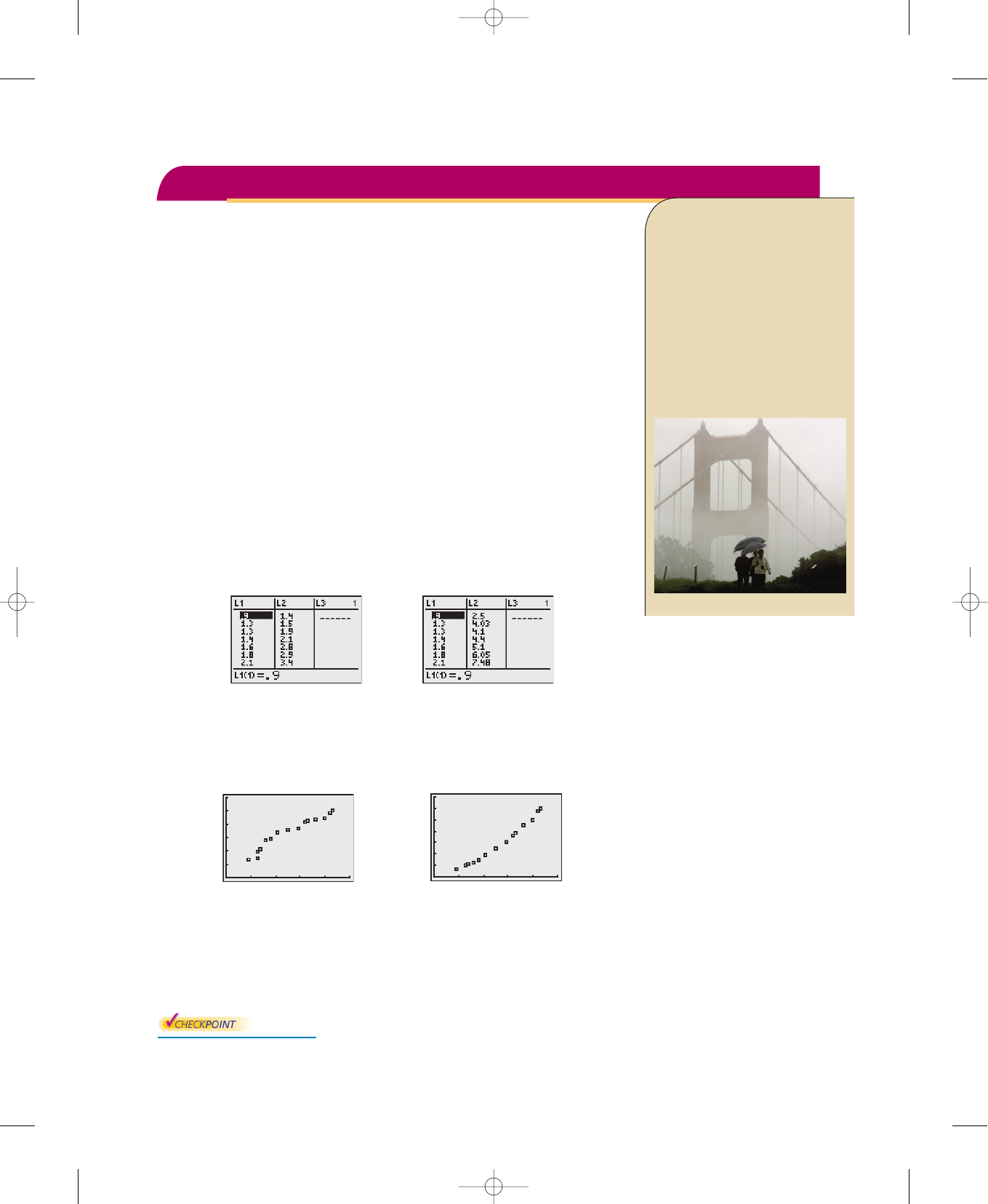
3.7 Quadratic Models
What you should learn
䊏 Classify scatter plots.
䊏 Use scatter plots and a graphing utility
to find quadratic models for data.
䊏 Choose a model that best fits a set of data.
Why you should learn it
Many real-life situations can be modeled by
quadratic equations.For instance,in Exercise
15 on page 321,a quadratic equation is used
to model the monthly precipitation for
San Francisco,California.
Justin Sullivan/Getty Images
Section 3.7 Quadratic Models 317
Classifying Scatter Plots
In real life, many relationships between two variables are parabolic, as in Section
3.1, Example 5. A scatter plot can be used to give you an idea of which type of
model will best fit a set of data.
Example 1 Classifying Scatter Plots
Decide whether each set of data could be better modeled by a linear model,
or a quadratic model,
a.
b.
Solution
Begin by entering the data into a graphing utility, as shown in Figure 3.62.
(a) (b)
Figure 3.62
Then display the scatter plots, as shown in Figure 3.63.
(a) (b)
Figure 3.63
From the scatter plots, it appears that the data in part (a) follow a linear pattern.
So, it can be better modeled by a linear function. The data in part (b) follow a
parabolic pattern. So, it can be better modeled by a quadratic function.
Now try Exercise 3.
0
05
28
0
05
6
共
4.3, 23.9
兲共
4.2, 23.0
兲
,
共
4.0, 19.9
兲
,
共
3.6, 18.1
兲
,
共
3.3, 15.2
兲
,
共
3.2, 14.3
兲
,
共
2.9, 12.4
兲
,
共
2.5, 9.8
兲
,
共
2.1, 7.6
兲
,
共
2.1, 7.48
兲
,
共
1.8, 6.05
兲
,
共
1.6, 5.1
兲
,
共
1.4, 4.4
兲
,
共
1.3, 4.1
兲
,
共
1.3, 4.03
兲
,
共
0.9, 2.5
兲
,
共
4.3, 5.0
兲共
4.2, 4.8
兲
,
共
4.0, 4.5
兲
,
共
3.6, 4.4
兲
,
共
3.3, 4.3
兲
,
共
3.2, 4.2
兲
,
共
2.9, 3.7
兲
,
共
2.5, 3.6
兲
,
共
2.1, 3.4
兲
,
共
2.1, 3.4
兲
,
共
1.8, 2.9
兲
,
共
1.6, 2.8
兲
,
共
1.4, 2.1
兲
,
共
1.3, 1.9
兲
,
共
1.3, 1.5
兲
,
共
0.9, 1.4
兲
,
y ⫽ ax
2
⫹ bx ⫹ c.y ⫽ ax ⫹ b,
333371_0307.qxp 12/27/06 1:33 PM Page 317

318 Chapter 3 Polynomial and Rational Functions
0
080
40
y = −0.0082x
2
+ 0.746x + 13.47
For instructions on how to use the regression
feature, see Appendix A; for specific keystrokes, go to this textbook’s Online
Study Center.
TECHNOLOGY S U P P O R T
Fitting a Quadratic Model to Data
In Section 2.7, you created scatter plots of data and used a graphing utility to find
the least squares regression lines for the data. You can use a similar procedure to
find a model for nonlinear data. Once you have used a scatter plot to determine
the type of model that would best fit a set of data, there are several ways that you
can actually find the model. Each method is best used with a computer or
calculator, rather than with hand calculations.
Example 2 Fitting a Quadratic Model to Data
A study was done to compare the speed x (in miles per hour) with the mileage y
(in miles per gallon) of an automobile. The results are shown in the table.
(Source: Federal Highway Administration)
a. Use a graphing utility to create a scatter plot of the data.
b. Use the regression feature of the graphing utility to find a model that best fits
the data.
c. Approximate the speed at which the mileage is the greatest.
Solution
a. Begin by entering the data into a graphing utility and displaying the scatter
plot, as shown in Figure 3.64. From the scatter plot, you can see that the data
appears to follow a parabolic pattern.
b. Using the regression feature of a graphing utility, you can find the quadratic
model, as shown in Figure 3.65. So, the quadratic equation that best fits the
data is given by
Quadratic model
c. Graph the data and the model in the same viewing window, as shown in Figure
3.66. Use the maximum feature or the zoom and trace features of the graphing
utility to approximate the speed at which the mileage is greatest. You should
obtain a maximum of approximately as shown in Figure 3.66. So, the
speed at which the mileage is greatest is about 47 miles per hour.
Figure 3.64 Figure 3.65 Figure 3.66
Now try Exercise 15.
0
080
40
共
45, 30
兲
,
y ⫽⫺0.0082x
2
⫹ 0.746x ⫹ 13.47.
Speed, x Mileage, y
15 22.3
20 25.5
25 27.5
30 29.0
35 28.8
40 30.0
45 29.9
50 30.2
55 30.4
60 28.8
65 27.4
70 25.3
75 23.3
333371_0307.qxp 12/27/06 1:33 PM Page 318
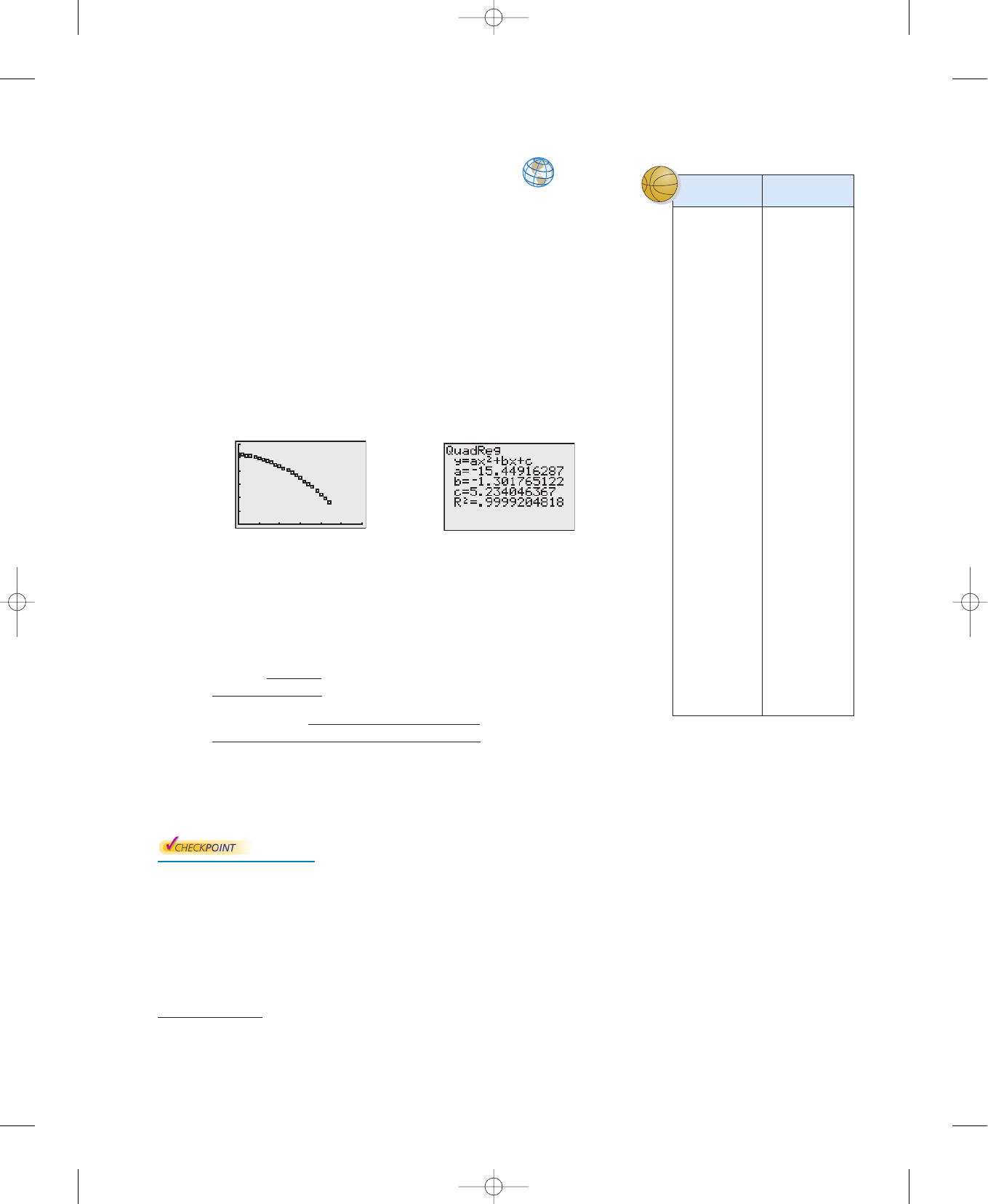
Section 3.7 Quadratic Models 319
Example 3 Fitting a Quadratic Model to Data
A basketball is dropped from a height of about 5.25 feet. The height of the
basketball is recorded 23 times at intervals of about 0.02 second.* The results are
shown in the table. Use a graphing utility to find a model that best fits the data.
Then use the model to predict the time when the basketball will hit the ground.
Solution
Begin by entering the data into a graphing utility and displaying the scatter plot,
as shown in Figure 3.67. From the scatter plot, you can see that the data has a
parabolic trend. So, using the regression feature of the graphing utility, you can
find the quadratic model, as shown in Figure 3.68. The quadratic model that best
fits the data is given by
Quadratic model
Figure 3.67 Figure 3.68
Using this model, you can predict the time when the basketball will hit the ground
by substituting 0 for y and solving the resulting equation for x.
Write original model.
Substitute 0 for y.
Quadratic Formula
Substitute for a, b, and c.
Choose positive solution.
So, the solution is about 0.54 second. In other words, the basketball will continue
to fall for about second more before hitting the ground.
Now try Exercise 17.
0.54 ⫺ 0.44 ⫽ 0.1
⬇ 0.54
⫽
⫺
共
⫺1.30
兲
±
冪
共
⫺1.30
兲
2
⫺ 4
共
⫺15.449
兲共
5.2
兲
2
共
⫺15.449
兲
x ⫽
⫺b
±
冪
b
2
⫺ 4ac
2a
0 ⫽⫺15.449x
2
⫺ 1.30x ⫹ 5.2
y ⫽⫺15.449x
2
⫺ 1.30x ⫹ 5.2
0
0 0.6
6
y ⫽⫺15.449x
2
⫺ 1.30x ⫹ 5.2.
Choosing a Model
Sometimes it is not easy to distinguish from a scatter plot which type of model
will best fit the data. You should first find several models for the data, using the
Library of Parent Functions, and then choose the model that best fits the data by
comparing the y-values of each model with the actual y-values.
*Data was collected with a Texas Instruments CBL (Calculator-Based Laboratory) System.
Time, x Height, y
0.0 5.23594
0.02 5.20353
0.04 5.16031
0.06 5.09910
0.08 5.02707
0.099996 4.95146
0.119996 4.85062
0.139992 4.74979
0.159988 4.63096
0.179988 4.50132
0.199984 4.35728
0.219984 4.19523
0.23998 4.02958
0.25993 3.84593
0.27998 3.65507
0.299976 3.44981
0.319972 3.23375
0.339961 3.01048
0.359961 2.76921
0.379951 2.52074
0.399941 2.25786
0.419941 1.98058
0.439941 1.63488
333371_0307.qxp 12/27/06 1:33 PM Page 319

320 Chapter 3 Polynomial and Rational Functions
TECHNOLOGY TIP
When you use the regression feature of a graphing
utility, the program may output an “ -value.” This -value is the coefficient
of determination of the data and gives a measure of how well the model fits
the data. The coefficient of determination for the linear model in Example 4 is
and the coefficient of determination for the quadratic model is
Because the coefficient of determination for the quadratic model
is closer to 1, the quadratic model better fits the data.
r
2
⬇ 0.99456.
r
2
⬇ 0.97629
r
2
r
2
Example 4 Choosing a Model
The table shows the amounts y (in billions of dollars) spent on admission to
movie theaters in the United States for the years 1997 to 2003. Use the regression
feature of a graphing utility to find a linear model and a quadratic model for the
data. Determine which model better fits the data. (Source: U.S. Bureau of
Economic Analysis)
Solution
Let x represent the year, with corresponding to 1997. Begin by entering the
data into the graphing utility. Then use the regression feature to find a linear
model (see Figure 3.69) and a quadratic model (see Figure 3.70) for the data.
Figure 3.69 Linear Model Figure 3.70 Quadratic Model
So, a linear model for the data is given by
Linear model
and a quadratic model for the data is given by
Quadratic model
Plot the data and the linear model in the same viewing window, as shown
in Figure 3.71. Then plot the data and the quadratic model in the same viewing
window, as shown in Figure 3.72. To determine which model fits the data better,
compare the y-values given by each model with the actual y-values. The model
whose y-values are closest to the actual values is the better fit. In this case, the
better-fitting model is the quadratic model.
Figure 3.71 Figure 3.72
Now try Exercise 18.
0
024
16
y = − 0.049x
2
+ 1.59x − 2.6
0
024
16
y = 0.62x + 2.1
y ⫽⫺0.049x
2
⫹ 1.59x ⫺ 2.6.
y ⫽ 0.62x ⫹ 2.1
x ⫽ 7
Yea r Amount, y
1997 6.3
1998 6.9
1999 7.9
2000 8.6
2001 9.0
2002 9.6
2003 9.9
333371_0307.qxp 12/27/06 1:33 PM Page 320
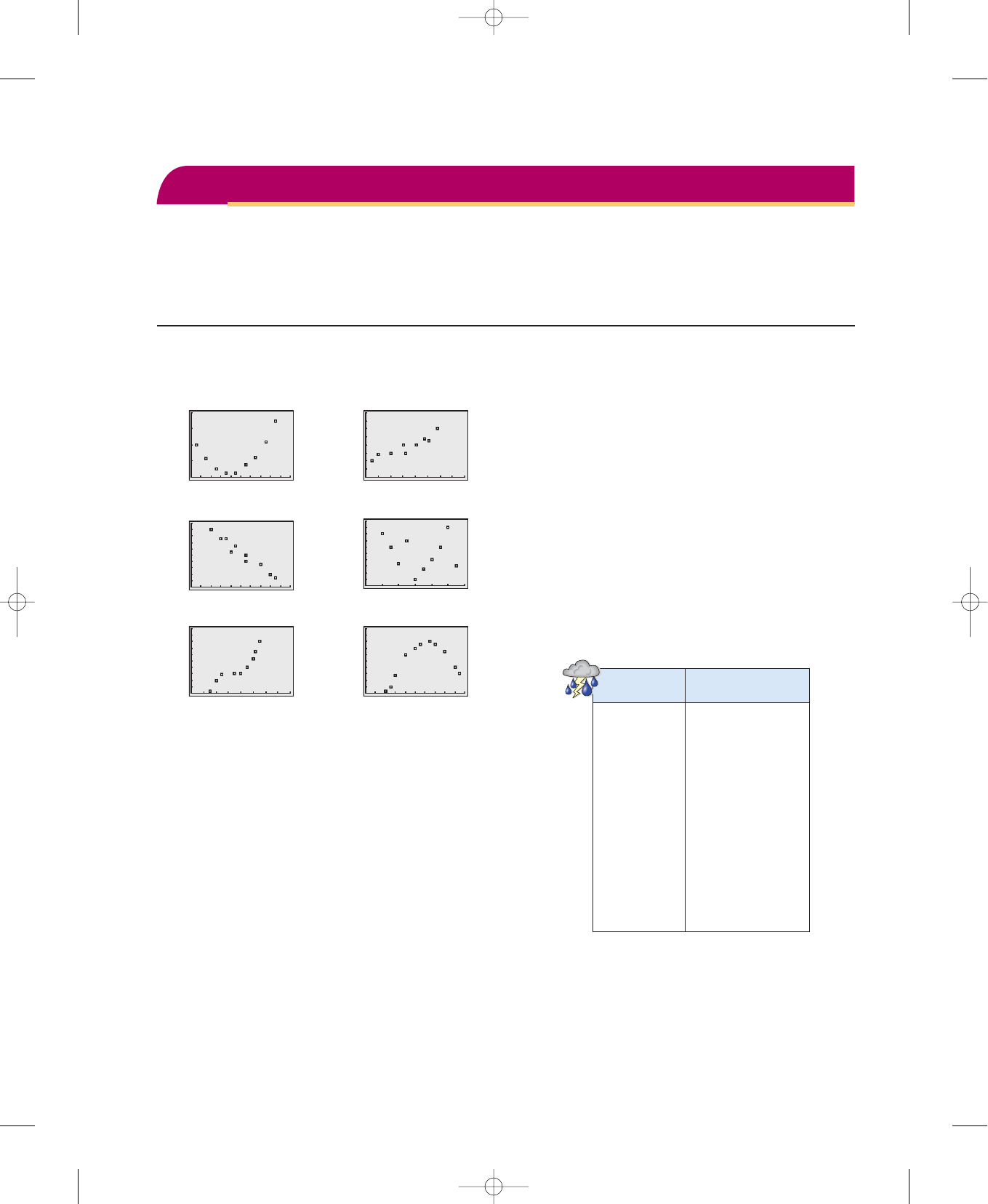
Section 3.7 Quadratic Models 321
In Exercises 1–6, determine whether the scatter plot could
best be modeled by a linear model, a quadratic model, or
neither.
1. 2.
3. 4.
5. 6.
In Exercises 7–10, (a) use a graphing utility to create a
scatter plot of the data, (b) determine whether the data
could be better modeled by a linear model or a quadratic
model, (c) use the regression feature of a graphing utility to
find a model for the data, (d) use a graphing utility to graph
the model with the scatter plot from part (a), and (e) create
a table comparing the original data with the data given by
the model.
7.
8.
9.
10.
In Exercises 11–14, (a) use the regression feature of a
graphing utility to find a linear model and a quadratic
model for the data, (b) determine the coefficient of determi-
nation for each model, and (c) use the coefficient of
determination to determine which model fits the data better.
11.
12.
13.
14.
15. Meteorology The table shows the monthly normal
precipitation P (in inches) for San Francisco, California.
(Source: U.S. National Oceanic and Atmospheric
Administration)
(a) Use a graphing utility to create a scatter plot of the
data. Let t represent the month, with
corresponding to January.
(b) Use the regression feature of a graphing utility to find
a quadratic model for the data.
t ⫽ 1
共
25, 430
兲共
20, 436
兲
,
共
15, 478
兲
,
共
10, 512
兲
,
共
5, 551
兲
,
共
0, 587
兲
,
共
⫺5, 653
兲
,
共
⫺10, 704
兲
,
共
⫺15, 744
兲
,
共
⫺20, 805
兲
,
共
12, ⫺5.3
兲共
10, ⫺3.6
兲
,
共
8, ⫺1.8
兲
,
共
6, ⫺0.1
兲
,
共
4, 1.7
兲
,
共
2, 3.5
兲
,
共
0, 5.4
兲
,
共
⫺2, 7.0
兲
,
共
⫺4, 9.0
兲
,
共
⫺6, 10.7
兲
,
共
9, 19.0
兲共
8, 16.8
兲
,
共
7, 14.5
兲
,
共
6, 12.6
兲
,
共
5, 10.5
兲
,
共
4, 8.3
兲
,
共
3, 6.3
兲
,
共
2, 4.1
兲
,
共
1, 2.0
兲
,
共
0, 0.1
兲
,
共
10, 27.1
兲共
9, 24.0
兲
,
共
8, 20.1
兲
,
共
7, 17.5
兲
,
共
6, 15.0
兲
,
共
5, 13.9
兲
,
共
4, 10.6
兲
,
共
3, 8.8
兲
,
共
2, 6.5
兲
,
共
1, 4.0
兲
,
共
22, 5325
兲共
20, 6125
兲
,
共
18, 6820
兲
,
共
16, 7325
兲
,
共
14, 7700
兲
,
共
12, 7975
兲
,
共
10, 7590
兲
,
共
8, 7915
兲
,
共
6, 7710
兲
,
共
4, 7335
兲
,
共
2, 6815
兲
,
共
0, 6140
兲
,
共
55, 5010
兲共
50, 3500
兲
,
共
45, 2225
兲
,
共
40, 1275
兲
,
共
35, 575
兲
,
共
30, 145
兲
,
共
25, 12
兲
,
共
20, 150
兲
,
共
15, 565
兲
,
共
10, 1250
兲
,
共
5, 2235
兲
,
共
0, 3480
兲
,
共
8, 9.0
兲共
7, 9.2
兲
,
共
6, 9.4
兲
,
共
5, 9.4
兲
,
共
4, 9.6
兲
,
共
3, 9.9
兲
,
共
2, 10.1
兲
,
共
1, 10.3
兲
,
共
0, 10.4
兲
,
共
⫺1, 10.7
兲
,
共
⫺2, 11.0
兲
,
共
10, 3.6
兲共
9, 3.5
兲
,
共
8, 3.4
兲
,
共
7, 3.2
兲
,
共
6, 3.0
兲
,
共
5, 3.0
兲
,
共
4, 2.9
兲
,
共
3, 2.8
兲
,
共
2, 2.5
兲
,
共
1, 2.4
兲
,
共
0, 2.1
兲
,
0
010
10
0
08
10
0
06
10
0
010
10
0
08
8
0
020
8
3.7 Exercises See www.CalcChat.com for worked-out solutions to odd-numbered exercises.
Vocabulary Check
Fill in the blanks.
1. A scatter plot with either a positive or a negative correlation can be better modeled by a _______ equation.
2. A scatter plot that appears parabolic can be better modeled by a _______ equation.
Month Precipitation, P
January 4.45
February 4.01
March 3.26
April 1.17
May 0.38
June 0.11
July 0.03
August 0.07
September 0.20
October 1.40
November 2.49
December 2.89
333371_0307.qxp 12/27/06 1:33 PM Page 321
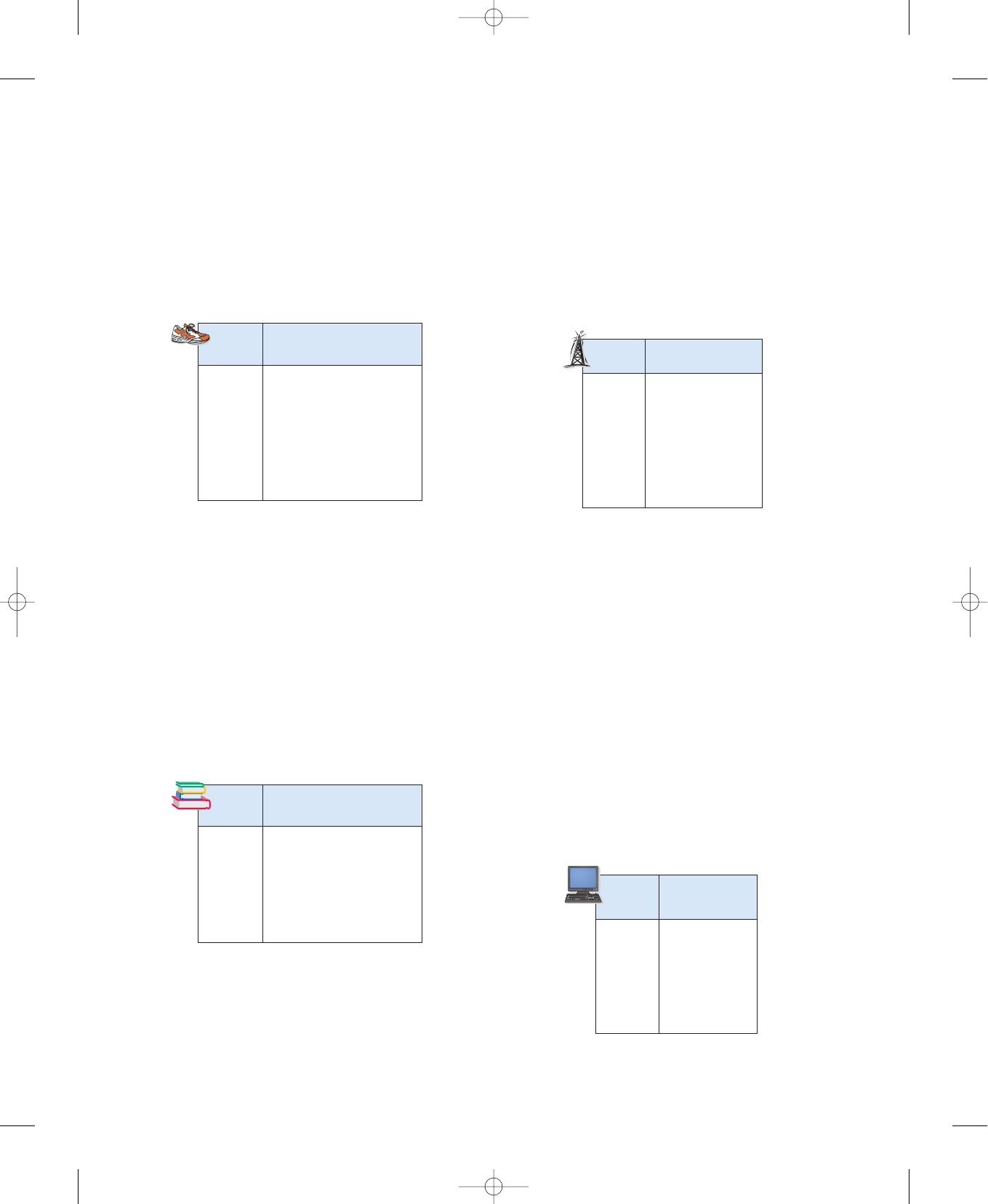
322 Chapter 3 Polynomial and Rational Functions
(c) Use a graphing utility to graph the model with the scat-
ter plot from part (a).
(d) Use the graph from part (c) to determine in which
month the normal precipitation in San Francisco is the
least.
16. Sales The table shows the sales S (in millions of dollars)
for jogging and running shoes from 1998 to 2004.
(Source: National Sporting Goods Association)
(a) Use a graphing utility to create a scatter plot of the
data. Let t represent the year, with corresponding
to 1998.
(b) Use the regression feature of a graphing utility to find
a quadratic model for the data.
(c) Use a graphing utility to graph the model with the
scatter plot from part (a).
(d) Use the model to find when sales of jogging and
running shoes will exceed 2 billion dollars.
(e) Is this a good model for predicting future sales?
Explain.
17. Sales The table shows college textbook sales (in
millions of dollars) in the United States from 2000 to 2005.
(Source: Book Industry Study Group, Inc.)
(a) Use a graphing utility to create a scatter plot of the
data. Let t represent the year, with corresponding
to 2000.
(b) Use the regression feature of a graphing utility to find
a quadratic model for the data.
(c) Use a graphing utility to graph the model with the
scatter plot from part (a).
(d) Use the model to find when the sales of college
textbooks will exceed 10 billion dollars.
(e) Is this a good model for predicting future sales?
Explain.
18. Media The table shows the numbers S of FM radio
stations in the United States from 1997 to 2003. (Source:
Federal Communications Commission)
(a) Use a graphing utility to create a scatter plot of the
data. Let t represent the year, with corresponding
to 1997.
(b) Use the regression feature of a graphing utility to find
a linear model for the data and identify the coefficient
of determination.
(c) Use a graphing utility to graph the model with the
scatter plot from part (a).
(d) Use the regression feature of a graphing utility to find
a quadratic model for the data and identify the coeffi-
cient of determination.
(e) Use a graphing utility to graph the quadratic model
with the scatter plot from part (a).
(f) Which model is a better fit for the data?
(g) Use each model to find when the number of FM
stations will exceed 7000.
19. Entertainment The table shows the amounts A (in dol-
lars) spent per person on the Internet in the United States
from 2000 to 2005. (Source: Veronis Suhler Stevenson)
t ⫽ 7
t ⫽ 0
S
t ⫽ 8
Yea r FM stations, S
1997 5542
1998 5662
1999 5766
2000 5892
2001 6051
2002 6161
2003 6207
Year
Amount, A
(in dollars)
2000 49.64
2001 68.94
2002 84.76
2003 96.35
2004 107.02
2005 117.72
Year
Sales, S
(in millions of dollars)
1998 1469
1999 1502
2000 1638
2001 1670
2002 1733
2003 1802
2004 1838
Year
Textbook sales, S
(in millions of dollars)
2000 4265.2
2001 4570.7
2002 4899.1
2003 5085.9
2004 5478.6
2005 5703.2
333371_0307.qxp 12/27/06 1:33 PM Page 322
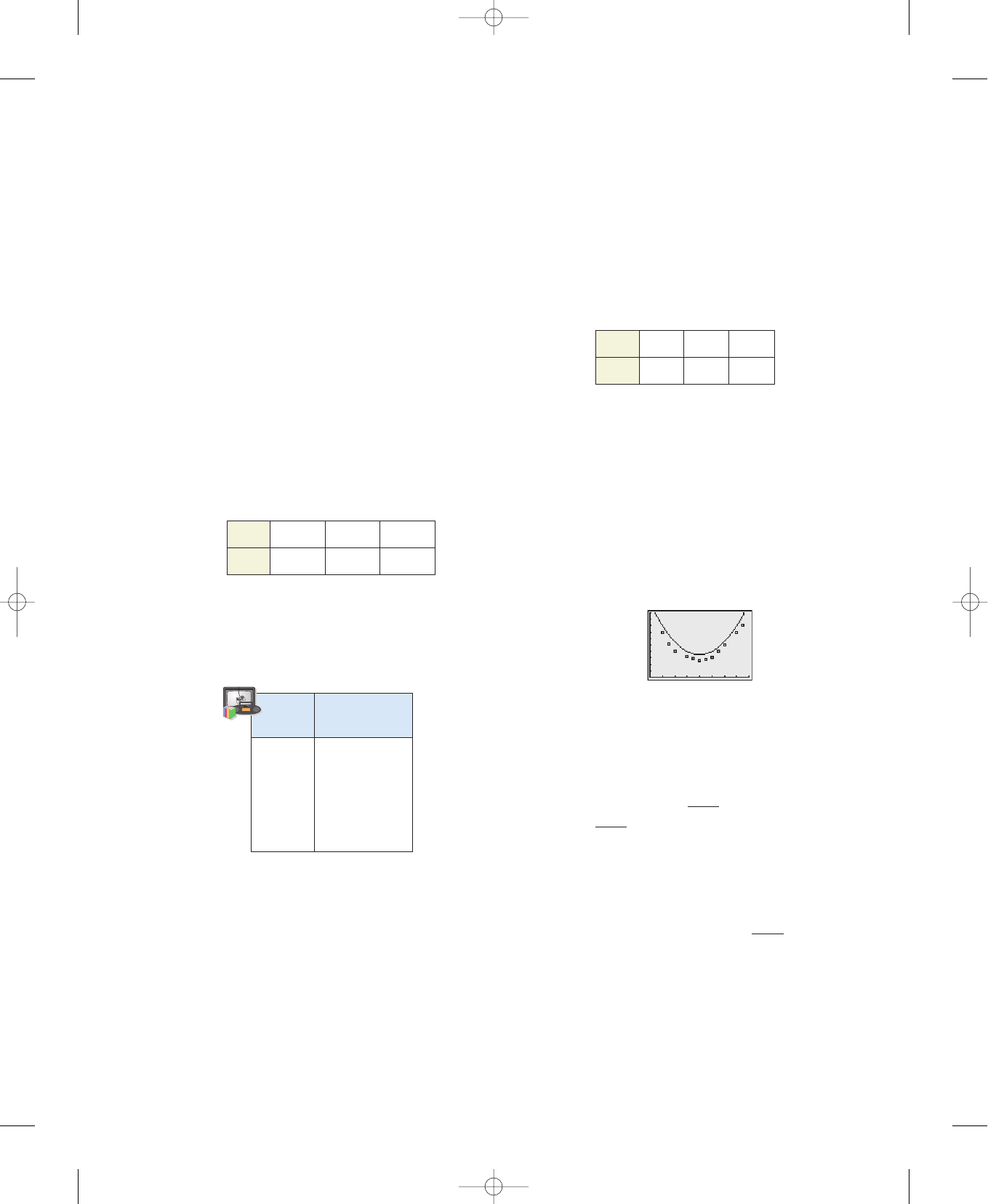
Section 3.7 Quadratic Models 323
(a) Use a graphing utility to create a scatter plot of the
data. Let t represent the year, with corresponding
to 2000.
(b) A cubic model for the data is
which has an -value of
0.99992. Use a graphing utility to graph this model
with the scatter plot from part (a). Is the cubic model a
good fit for the data? Explain.
(c) Use the regression feature of a graphing utility to find
a quadratic model for the data and identify the coeffi-
cient of determination.
(d) Use a graphing utility to graph the quadratic model
with the scatter plot from part (a). Is the quadratic
model a good fit for the data? Explain.
(e) Which model is a better fit for the data? Explain.
(f) The projected amounts A* spent per person on the
Internet for the years 2006 to 2008 are shown in the
table. Use the models from parts (b) and (c) to predict
the amount spent for the same years. Explain why your
values may differ from those in the table.
20. Entertainment The table shows the amounts A (in hours)
of time per person spent watching television and movies,
listening to recorded music, playing video games, and
reading books and magazines in the United States from
2000 to 2005. (Source: Veronis Suhler Stevenson)
(a) Use a graphing utility to create a scatter plot of the
data. Let t represent the year, with corresponding
to 2000.
(b) A cubic model for the data is
which has an -value of
Use a graphing utility to graph this model
with the scatter plot from part (a). Is the cubic model a
good fit for the data? Explain.
(c) Use the regression feature of a graphing utility to find
a quadratic model for the data and identify the coeffi-
cient of determination.
(d) Use a graphing utility to graph the quadratic model
with the scatter plot from part (a). Is the quadratic
model a good fit for the data? Explain.
(e) Which model is a better fit for the data? Explain.
(f) The projected amounts A* of time spent per person for
the years 2006 to 2008 are shown in the table. Use the
models from parts (b) and (c) to predict the number of
hours for the same years. Explain why your values may
differ from those in the table.
Synthesis
True or False? In Exercises 21 and 22, determine whether
the statement is true or false. Justify your answer.
21. The graph of a quadratic model with a negative leading
coefficient will have a maximum value at its vertex.
22. The graph of a quadratic model with a positive leading
coefficient will have a minimum value at its vertex.
23. Writing Explain why the parabola shown in the figure is
not a good fit for the data.
Skills Review
In Exercises 24–27, find (a) and (b)
24.
25.
26.
27.
In Exercises 28–31, determine algebraically whether the
function is one-to-one. If it is, find its inverse function.
Verify your answer graphically.
28. 29.
30. 31.
In Exercises 32–35, plot the complex number in the complex
plane.
32.
33.
34. 35. 8i⫺5i
⫺2 ⫹ 4i1 ⫺ 3i
x
≥
0f
共
x
兲
⫽ 2x
2
⫺ 3,x
≥
0f
共
x
兲
⫽ x
2
⫹ 5,
f
共
x
兲
⫽
x ⫺ 4
5
f
共
x
兲
⫽ 2x ⫹ 5
g
共
x
兲
⫽ x
3
⫺ 5f
共
x
兲
⫽
3
冪
x ⫹ 5,
g
共
x
兲
⫽
3
冪
x ⫹ 1f
共
x
兲
⫽ x
3
⫺ 1,
g
共
x
兲
⫽ 2x
2
⫺ 1f
共
x
兲
⫽ 5x ⫹ 8,
g
共
x
兲
⫽ x
2
⫹ 3f
共
x
兲
⫽ 2x ⫺ 1,
g
⬚
f.f
⬚
g
0
08
10
0.99667.
r
2
13.61t
2
⫹ 33.2t ⫹ 3493
A ⫽
⫺
1.500t
3
⫹
t ⫽ 0
r
2
3.0440t
2
⫹ 22.485t ⫹ 49.55
S ⫽ 0.25444t
3
⫺
t ⫽ 0
Year 2006 2007 2008
A*
127.76 140.15 154.29
Year 2006 2007 2008
A*
3890 3949 4059
Year
Amount, A
(in hours)
2000 3492
2001 3540
2002 3606
2003 3663
2004 3757
2005 3809
DISC 1
TRACK 4
333371_0307.qxp 1/2/07 9:50 AM Page 323
